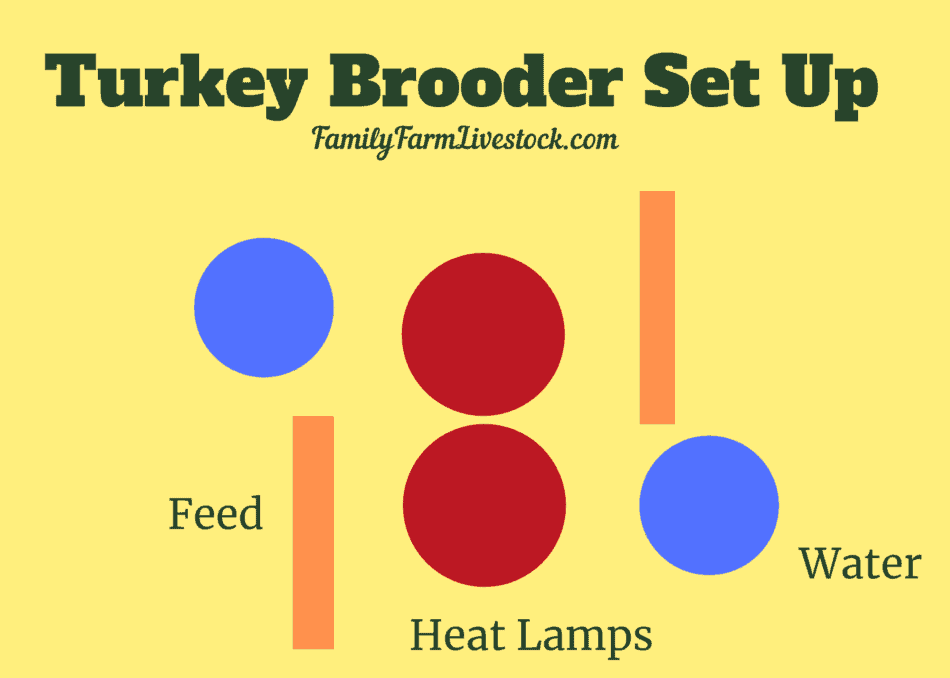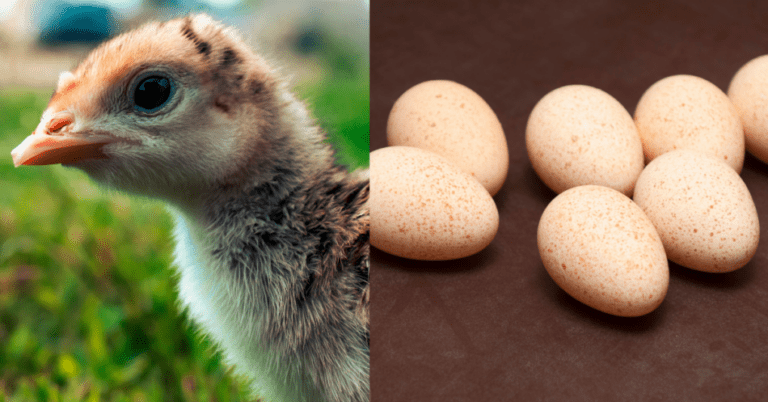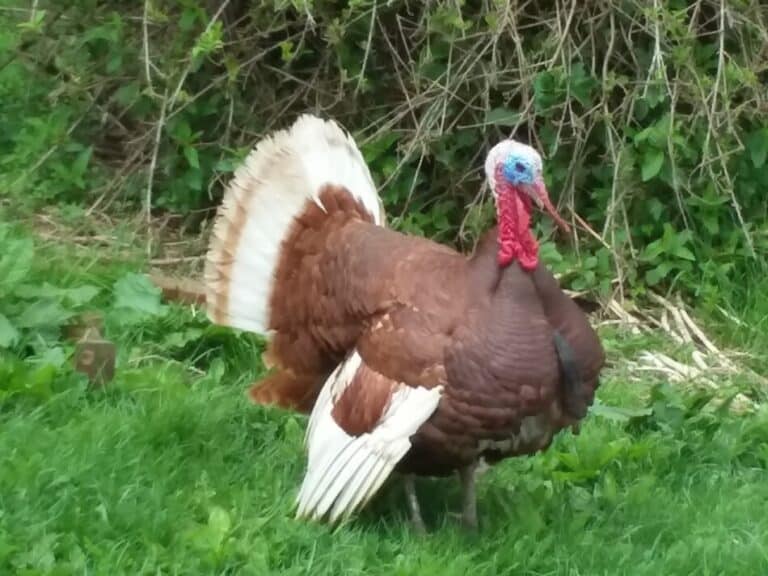How To Raise Turkey Poults (Including Brooder Set Up)

Thinking about raising some turkey poults this year? Turkeys are interesting birds and tons better in both taste and quality than the turkey at the store!
The key to success with poults all starts in the brooder. Your job is to keep them stress free, including heat, feed and environmental stress. Happy turkeys grow well, stressed turkeys do not.
Turkey poults need a 95 degree brooder, 28% non medicated feed, clean water and predator protection.
Brooder supplies check list:
- minimum of 2 trough feeders, with 1″ of feeder space per poult
- minimum of 2 waterers, with 0.5″ of waterer space per poult
- heat source, if using heat lamps have a spare bulb
- bedding material

Have brooder set up and warm before poults arrive!
You’ll want to have the brooder warm before you get the poults, this way they go into a nice, comfortable brooder and can get settled in to their new home right away.
Turn your heat source on a few hours before you get the poults. You want the heat a few inches off the ground to be 95 degrees. Raise or lower the lamp to get this temperature.
The heat circle under the heat lamp will be warm almost instantly, but turning it on early gives the whole brooder area time to warm up.
This will also give you a last minute check to make sure everything in your brooder is working. If things aren’t going as planned, you still have time to fix it before the poults arrive.
We have had new, straight out of the box, heat lamp bulbs not work! Yikes! If that is your only bulb or you need it right now, you are in a tight spot. If you are working ahead of time, you’ve got the time to find another one.
Brooder needs feed, feeder, waterer, heat source, protection
The number of poults you have will determine the minimum size of the brooder. Read my article Space To Raise Turkeys for the details.
As long as you can keep the predators out, you can make a brooder as big as you want it to be, however, it’s easier to take care of (mainly keeping the heat in) if the area is not overly large.
The brooder must have:
- bedding
- multiple feeders
- multiple waterers
- a heat source
- complete predator protection.
We have always used heat lamps with the red bulbs for a heat source. If we need more heat, we hang another lamp. Don’t hang the heat lamp by the cord, hang it from the wire swivel at the base of the bulb.
Here is a bit of counterintuitive information, the brooder should have both heated areas and unheated areas. Set up your brooder so the poults can hang out in the warm spots, but walk to the cooler spots for food and water.
When the poults are brand new, keep everything pretty close together, then expand their area a bit as they grow.
Your turkeys will need the brooder for 6 weeks
The turkey poults will need to be in the brooder for the first 6 weeks. If it is really warm where you live, you may be able to turn off the heat sooner, or just use the heat at night or on cooler days.
Start the brooder temperature at 95 and lower it 5 degrees every week until you get to a temperature close to the outside temperature.
After the brooder, turkeys still need care
Once your turkey poults are big enough to leave the brooder, realize that your job as poult manager is shifting, not over. Half grown poults still need care and monitoring.
The best way to handle letting poults out of the brooder is to give them a new, smaller paddock area that is 3 or 4 times as big as the brooder and see how they handle being out.
Ideally, this new area will be attached to the brooder, so the poults can just walk back inside when they want or need to. If the new pen area is not attached to the brooder, this new pen needs shelter, predator protection, feed and water.
If you have a chicken tractor to use, put your poults in it. Just be careful when you are moving the chicken tractor to a new spot, the first few moves are easier to do with help.
Do not let poults freely roam!
Do not just let your poults out into your yard! They are still fragile and need your care, especially in the case of rain. Poults left out in the rain will die from heat loss, they must have a good shelter and know how to get into it easily.
Heritage breed turkeys will be more capable of getting out of fences, they can fly enough to hop over. If you have broad breasted turkeys, this won’t be a problem, these birds grow fast enough to out weigh their ability to fly.
In case you are not aware, turkey poults are predator magnets! Everything is hoping to eat them, your cat included! Rats will dig into the brooder to steal baby poultry.
Poults need 28% feed, nothing less will do
Your day old poults need a 28% turkey starter feed for the first few weeks. As they grow, the feed can drop off in protein percentage, but it will always be higher than chickens. This also means it will be more expensive, buy it anyway.
You can give poults gamebird feed instead of turkey starter or, as they get older, turkey grower. The gamebird feed will be a 30% for the starter, versus the 28% you need, but higher is okay, lower is not.
Best Feed For Turkeys will show you which feed your birds need and when to switch feed formulations.
In some areas, turkey specific feeds are hard to come by or unreliably in stock. This is the case around here, so we use the gamebird feeds that are always available and work great.
Broad Breasted Tom turkeys will be fully grown in 16 weeks, hens 20 weeks
Your turkeys are going to be fully grown in 16-20 weeks, if you have broad breasted birds. 16 weeks is for the toms, closer to 20 for the hens, since the hens are smaller.
This is super fast growth, which requires nutrition that is on point. To make sure your turkeys are getting what they need, keep them on a turkey specific feed for the entire time you have them.
If you have your birds eating grass, super, turkeys love pecking around for snacks, just keep the free choice feed available, as well.
Heritage breed turkeys will take 24-28 weeks to finish growing
If you have heritage breed turkeys, your grow out time is going to be longer, more like 24-28 weeks. You’ll also have a smaller bird when you are finished, this is just the nature of the breed not a reflection of your care or feeding.
If you want to butcher them all on the same day, that’s fine. The hens will be smaller sized, but as far as eating goes, they’ll be wonderful, too!
If you are butchering your own birds, you can do them in batches, picking the biggest ones first. You’ll be surprised at how much those toms will weigh!
If you are not sure what weight your birds are at, grab one and put it on a scale. By this, I mean hold it while you weigh yourself then weigh yourself without the bird and subtract.
If you have a platform scale, use it, if not go for the bathroom scale plan. Either way, get a weight so you know where you are at. These toms can get so big, it’s hard to fit them in the oven!
Poults are stress sensitive
Turkey poults are very stress sensitive.
The catch with turkey poults is that they seem to be very stress sensitive, any little (or little to us) thing causes them problems. Problems that they seem to have trouble recovering from.
The good new here is this is only for the growing up period, once turkeys reach full size they are pretty durable and easy to handle, it’s getting them there that is the challenge.
So, how do you deal with the super stress sensitive poults? You follow the brooding and feeding instructions to a “T”. No modifications, no “I think this different way of doing things will be okay”, none of that. Just follow the directions.
Turkey poults get a bad reputation as far as being difficult to deal with, but they’re not. They are just very exact in their needs.
Poults seem to be less resilient than other hatchlings, like chicks or ducklings, which catches folks off guard because poults are bigger and we normally associate bigger with more hardy or more capable, in this case, not so.
Don’t let me scare you off of raising your own turkeys, if you give them what they need when they need it, your poults will grow well and stay healthy. It’s definitely doable, you just need to stick to the plan!
Have a few chicks to teach the poults to eat and drink
When you take the poults out of the shipping box, dip their beaks in the water before you set them down near the heat source.
Since getting poults to eat and drink is notoriously difficult, let me help you out! I have an entire article with tips on how to get turkey poults to eat and drink, check it out here, Getting Turkey Poults To Eat And Drink.
The easiest tip is to have a few chicks shipped with your turkey order. The chicks are willing to zoom around the brooder and investigate.
When the chicks find the food and water the poults will see the chick eating then copy the chick. To be clear, the chick you put in with the poults needs to be the same age (day old) as the poults.
Older chicks will be too aggressive and scare the poults, older chickens will be flat out mean to the poults, don’t use them, either!
Resources:
Penn State Extension Small Flock Turkey Production, feeder and waterer space per poult

